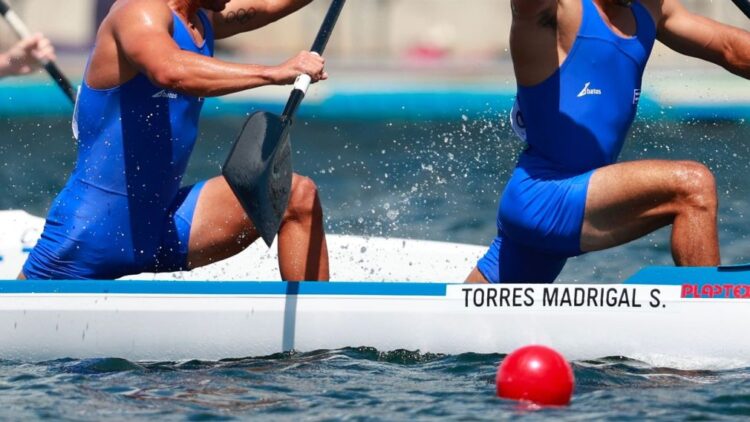
OBJECTIVE OF CANOE: Maneuver and manually row a boat to the finish line in the least amount of time possible.
NUMBER OF PLAYERS: 1-8 players
MATERIALS: Canoe/kayak, oar/paddle
TYPE OF GAME: Sport
AUDIENCE: 8+
OVERVIEW OF CANOE
The water-based sport of canoe includes two distinct disciplines: canoe sprint and canoe slalom. While canoe sprint is similar to Olympic rowing, canoe slalom involves competitors maneuvering around a fast-moving whitewater course. Interestingly, canoe events don’t always involve canoes; most canoe events feature a kayak alternative.
Sprint canoe’s organized history dates back to 1924, when a sprint canoe governing body was formed. It was a demonstration sport at the Paris games. Just 12 years later, the sprint canoe was featured for the first time in the 1936 Olympic Games. Now it common in international competition and countless world championships around the globe
Invented in 1933 in Switzerland as a summer alternative to slalom skiing, canoe slalom didn’t make an Olympic appearance until 1972, but it was dropped from the Olympics in 1976. Since 1992, the sport has been featured in every Summer Olympic Games.
SETUP
EQUIPMENT
- Canoe/Kayak: Canoes are generally slightly larger and wider than kayaks and feature a completely open deck. Kayaks are slim and feature an enclosed deck, with the only open portion being the area in which the kayaker sits.
- Oar/Paddle: Canoes are powered by a single blade paddle oar. Conversely, kayaks utilize a double-bladed paddle pulling them.
EVENTS
CANOE SPRINT
A canoe or kayak sprint most closely resembles an Olympic rowing race. A group of competitors, often up to eight in number, race down a completely straight course to the finish line. The track is usually split into nine lanes for the competitors.
In kayak sprint events, one, two, or four team members can be on a boat. The distances of each race depend on the gender of the competitors and the number of team members in each boat:
Men’s kayak sprint events include:
- Single 100 meters (328 feet)
- Single 1000 meters (3280 feet)
- Doubles 200 meters (656 feet)
- Doubles 1000 meters (3280 feet)
- Four-person 1000 meters (3280 feet)
Women’s kayak sprint events include:
- Single 200 meters (656 feet)
- Single 500 meters (1640 feet)
- Doubles 500 meters (1640 feet)
- Four-person 500 meters (1640 feet)
Interestingly, only men have ever competed in Olympic canoe events. Therefore, the only Olympic canoe events include:
- Men’s Events single 200 meters (656 feet)
- Men’s single 1000 meters (3280 feet)
CANOE SLALOM
A canoe or kayak slalom features a single competitor maneuvering through gates spread out across a fast-moving whitewater course.
Canoe slalom events are for single competitors only, with separate kayak and canoe events being available for both men and women.
Due to the rough waters in slalom events, special enclosed canoes (resembling that of a kayak) are used to prevent excessive water from entering the boat.
GAMEPLAY
CANOE SPRINT
Canoe/kayak sprint events begin just like any other racing event: all boats line up next to each other and race down a straight track toward the finish line.
CANOE SLALOM

Canoe/kayak slalom events begin with a single competitor calmly rowing toward a miniature “waterfall” of sorts. Upon entering the rough whitewater rapids, the time begins. The competitor must then maneuver through numerous gates that zig-zag down the course.
Throughout the slalom course lies 18 to 25 gates—some red, some green. Green gates are the simpler of the two gates, only having to be passed through in the downstream direction. Red gates are upstream gates—the competitor essentially makes a full circle through the gate by going slightly past it, paddling upstream through the gate, and then turning again back downstream.
Touching or missing any gates will result in extremely costly time penalties.
SCORING
CANOE SPRINT
As with all racing events, the competitor who crosses the finish line before all others is the winner of the race. However, only so many competitors take part in each race. Because of this, canoe sprints are often tournament-like, separating competitors into various heats. After a round is complete, a certain amount of teams with the best times move on to the next round, where this process repeats until the finals.
In the final round, the first team to cross the finish line wins the gold medal and is the champion of the event.
CANOE SLALOM
Canoe/kayak slalom is an entirely time-based event. Competitors are given two runs to vie for the fastest possible time. The lowest of these two times is the one that counts toward a competitor’s qualification for the next round.
Similar to the canoe sprint, competitors must qualify for successive rounds (heats, quarterfinals, semifinals, finals) by remaining near the top of the leaderboard with solid times. In the final round, the competitor with the fastest run (of their two attempts) wins the gold medal.
PADDLING TECHNIQUES

Other than the fact that canoes and kayaks look distinctly different, both require very separate paddling techniques.
Canoes are powered by a single-bladed oar. Because of this, competitors will row on a single side of the boat for the entirety of a race. Because canoes have an entirely open deck, competitors take advantage of this by using a half-kneeling/lunge stance while rowing, keeping one knee on the floor and the other leg forward and its foot flat on the floor. This form allows them to generate as much force as possible when paddling, although this technique also makes canoeing extremely fatiguing.
In contrast, kayaks are powered by a doubled-bladed paddle. Due to this design, competitors rotate their paddle for the entirety of a run to propel the boat forward, alternating from the left and right sides constantly. As kayaks have enclosed decks, competitors must sit while paddling.
Similar to kayaks, canoes made for slalom events are steered by a seated competitor. This is mainly because the whitewater rapids create a very unstable ride, meaning any competitor in the traditional half-kneeling stance would likely fall over instead a sitting position is preferred. Additionally, slalom canoes feature an enclosed deck like kayaks, which limits the space the competitor has to move around. However, these slalom canoes are still powered with a single-bladed oar.
END OF GAME
In kayak/canoe sprint events, the first team to cross the finish line of the final race is the winner.
In canoe/kayak slalom events, the competitor with the fastest run time is the winner.
- 30 GAMES TO PLAY OVER TEXT - April 22, 2024
- 20+ FREE PRINTABLE BABY SHOWER GAMES - April 16, 2024
- 20+ College Party Games for the Best Night Ever! - April 2, 2024